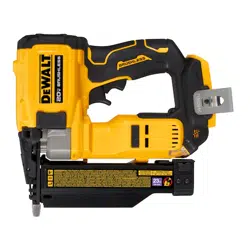Loading ...
Loading ...
Loading ...

ENGLISH
8
NOTE: To remove the battery pack, some chargers
require the battery pack release button to bepressed.
Hot/Cold Pack Delay
When the charger detects a battery pack that is too hot
or too cold, it automatically starts a Hot/Cold Pack Delay,
suspending charging until the battery pack has reached an
appropriate temperature. The charger then automatically
switches to the pack charging mode. This feature ensures
maximum battery packlife.
A cold battery pack may charge at a slower rate than a
warm batterypack.
The hot/cold pack delay will be indicated by the red light(s)
continuing to blink but with the yellow light continuously
ON. Once the battery pack has reached an appropriate
temperature, the yellow light will turn OFF and the charger
will resume the chargingprocedure.
DCB118 and DCB1112 Chargers
The DCB118 and DCB1112 chargers are equipped with
an internal fan designed to cool the battery pack. The fan
will turn on automatically when the battery pack needs to
becooled.
Never operate the charger if the fan does not operate
properly or if ventilation slots are blocked. Do not permit
foreign objects to enter the interior of thecharger.
Electronic Protection System
Li-Ion tools are designed with an Electronic Protection
System that will protect the battery pack against
overloading, overheating or deep discharge. The tool will
automatically turn off and the battery pack will need to
berecharged.
Important Charging Notes
1. Longest life and best performance can be obtained if
the battery pack is charged when the air temperature
is between 65°F – 75°F (18° C– 24°C). DO NOT charge
when the battery pack is below +40°F (+4.5°C), or
above +104°F (+40°C). This is important and will
prevent serious damage to the batterypack.
2. The charger and battery pack may become warm to the
touch while charging. This is a normal condition, and
does not indicate a problem. To facilitate the cooling of
the battery pack after use, avoid placing the charger or
battery pack in a warm environment such as in a metal
shed or an uninsulatedtrailer.
3. If the battery pack does not charge properly:
a. Check operation of receptacle by plugging in a lamp
or other appliance;
b. Check to see if receptacle is connected to a light
switch which turns power off when you turn out
the lights;
c. If charging problems persist, take the tool, battery
pack and charger to your local servicecenter.
4. You may charge a partially used pack whenever you
desire with no adverse effect on the batterypack.
plugged together, and nameplate ampere rating. If in
doubt, use the next heaviergauge.
Minimum Gauge for Cord Sets
Volts
Total Length of Cord in Feet
(meters)
120V 25 (7.6) 50 (15.2) 100 (30.5) 150 (45.7)
Ampere Rating
American Wire Gauge
More Than Not More
Than
0 6 18 16 16 14
6 10 18 16 14 12
10 12 16 16 14 12
12 16 14 12 Not Recommended
• Do not place any object on top of the charger or
place the charger on a soft surface that might block
the ventilation slots and result in excessive internal
heat. Place the charger in a position away from any heat
source. The charger is ventilated through slots in the top
and the bottom of thehousing.
• Do not operate the charger with a damaged cord
orplug. Have them replacedimmediately.
• Do not operate the charger if it has received a sharp
blow, been dropped or otherwise damaged in any
way. Take it to an authorized servicecenter.
• Do not disassemble the charger; take it to an
authorized service center when service or repair
is required. Incorrect reassembly may result in a risk of
electric shock, electrocution orfire.
• The charger is designed to operate on standard
120V household electrical power. Do not attempt to
use it on any other voltage. This does not apply to the
vehicularcharger.
• Foreign materials of a conductive nature, such as,
but not limited to, grinding dust, metal chips, steel
wool, aluminum foil or any buildup of metallic
particles should be kept away from the charger
cavities and ventilation slots.
• Always unplug the charger from the power supply
when there is no battery pack in thecavity.
Charging a Battery (Fig. C)
1. Plug the charger into an appropriate outlet.
2. Insert and fully seat battery pack. The red charging
light(s) will continuously blink whilecharging.
3. Charging is complete when the red charging light(s)
remain(s) continuously ON. Battery pack can be left in
charger or removed. Some chargers require the battery
pack release button to be pressed forremoval.
WARNING: Only charge batteries in air temperature
over 40° F (4.5° C) and below 104° F (+40°C).
4. Charger will not charge a faulty battery pack, which may
be indicated by the charging light(s) staying OFF. Take
charger and battery pack to an authorized service center
if light(s) stay(s)OFF.
NOTE: Refer to label near charging light(s) on
charger for blinkpatterns. Older chargers may have
additional information and/or may not have a yellow
indicatorlight.
Loading ...
Loading ...
Loading ...
